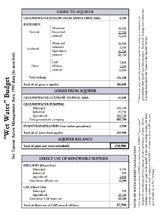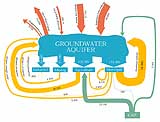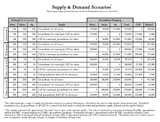
| AW, pp. 112 - 116 |
We invite you, the reader, to work through a series of options in order to shape your recommendations to decision makers. We begin by restating the overdraft problem, and determining how important achieving a sustainable water supply is to you. A simplified water balance was presented in bar chart form in the Preface (See page vi). This shows that in 1997, water demand in the TAMA totaled some 345,400 acre-feet. Renewable supplies, consisting of natural groundwater replenishment, CAP water, and effluent totaled only 194,500 acre-feet, leaving a water deficit of 150,900 acre-feet of mined groundwater. A somewhat more detailed water budget is depicted on the adjoining page. This information is graphically depicted as an “octopus” on the following page. The top section of the water budget lists all water sources that contribute to the aquifer, including natural, incidental, and direct recharge. Gains to the aquifer also include underground flow into our aquifer from the Santa Cruz AMA to the south. The center section of this water budget tallies losses from the aquifer, which are mainly groundwater pumping for municipal, industrial, and agricultural uses. Other losses from the aquifer include underground flow from our aquifer into the Pinal AMA to the north, and evapotranspiration from shallow groundwater. The bottom portion of the budget represents direct uses of effluent and CAP water, which are renewable supplies. While these uses do not directly affect the aquifer balance, there may be indirect impacts. For example, if CAP water was not available to irrigate some agricultural land, groundwater might be used instead. On the other hand, effluent not used to irrigate a golf course might be left in the riverbed, where much of it would become incidental recharge to the aquifer. The bottom line of this water budget is the same as in the bar chart in the introduction — we are pumping far more groundwater than is being replaced in the aquifer. This situation is not sustainable in the long run. The only options for approaching or attaining sustainability are making full use of our CAP allocation, severely limiting current and future water demand, or some combination of the two. How important is a sustainable water supply to you? Sustainability is not an all-or-nothing concept. When using our water supply, we have a range of choices, including the following:
Current state law directs us to aim towards prolonging the supply into the future, but does not require complete sustainability. This is because “Safe yield” allows a certain amount of groundwater mining. People who support sustainability or prolonging the life of the water supply are mainly concerned about:
Do you recognize your views in either list? Or do you identify with some statements from both lists? How much do you value a sustainable water supply? What kind of limitations are you willing to impose on others? What sacrifices are you willing to make?
Conventional wisdom is that most people in the community support either a sustainable supply or at least prolonging our supply. But there are many divergent views as how best to approach this goal. To balance supply and demand we can control water use and/or increase the supply. We can control water use by limiting the number of people using water and/or limiting the amount each person uses. We can also transfer water use from one sector to another (e.g., reduce agricultural activities to save water for other uses). Water supplies can be increased by capturing more rainwater and snow melt, importing and using water from elsewhere and accepting wastewater as a supply for more uses.
|


